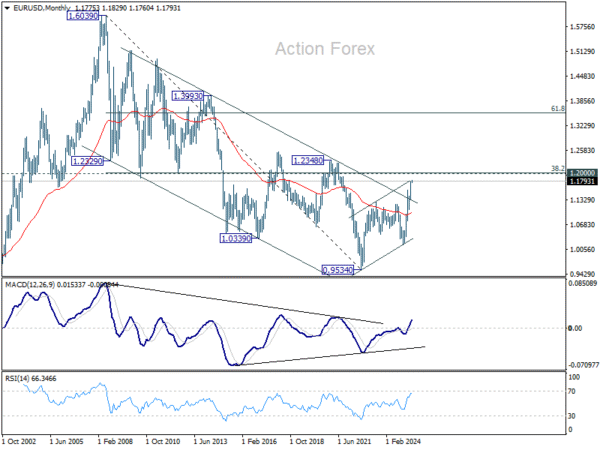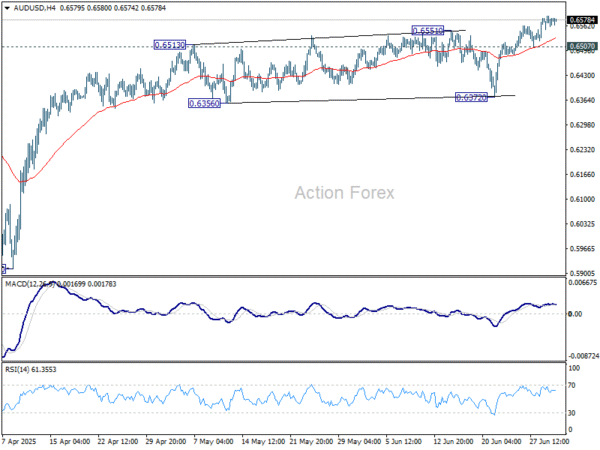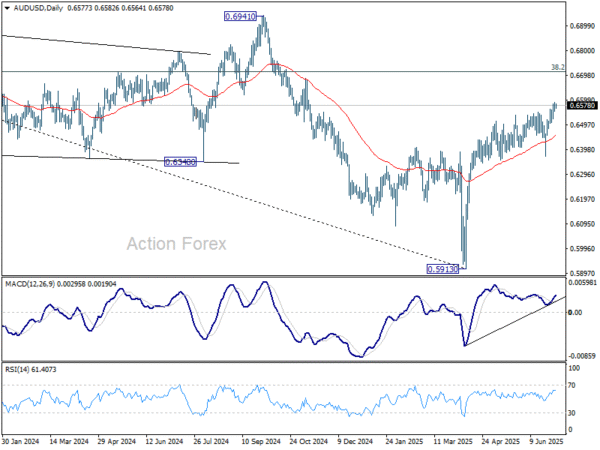The calm in today’s Asian forex session belies a volatile backdrop forming beneath the surface. Dollar remains pinned near at bottom of the performance board this week, despite a shallow bounce. Investors are keeping their powder dry ahead of several key catalysts: Thursday’s non-farm payrolls report, the looming July 9 tariff truce deadline, and a pivotal House vote on US President Donald Trump’s USD 3.3 trillion tax-and-spending bill. Volatility looks set to rise as these themes come to a head.
So far this week, Swiss Franc is the best-performing major currency, followed by Yen and Euro, suggesting defensive positioning remains intact. Sterling and Loonie trail the field after Dollar, while Aussie and Kiwi sit in middle positions.
The US Senate narrowly passed Trump’s legislation overnight—thanks to a tie-breaking vote from Vice President JD Vance. The measure now faces another battle in the House before July 4, where Republicans hold only a slim majority. Passage would intensify deficit concerns already weighing on Dollar.
Fed Chair Jerome Powell’s remarks at the ECB Forum yesterday were deliberately noncommittal, reiterating that all decisions depend on incoming data. With inflation still running above target and tariff uncertainty unresolved, most FOMC members have signaled reluctance to cut rates in July. Unless labor market weakness becomes more evident, the bar for near-term easing remains high. That puts even more focus on this week’s jobs data as the primary swing factor for Fed policy expectations and Dollar direction.
On the European front, ECB officials have taken the unusual step of pinpointing Euro levels. Vice President Luis de Guindos said that EUR/USD levels above 1.20 could become problematic for inflation. Latvian Governor Kazaks flagged the combined impact of tariffs and a stronger exchange rate as a drag on exports. This shift signals a degree of discomfort with Euro’s 9% rise against Dollar since early April.
EUR/USD is currently trading around 1.18, still below the informal ECB red line. For now, the pair still has room to run, but traders may begin to tread more carefully as it approaches the 1.2 zone. Technically, that also coincides with a long term fibonacci level, 38.2% retracement of 1.6039 (2008 high) to 0.9534 (2022 low) at 1.2019. EUR/USD’s reaction to this level is crucial in determining whether it’s just in a medium term corrective pattern from 0.9534. Or it’s actually reversing the down trend that lasted more than a decade and a half.
In Asia, at the time of writing, Nikkei is down -0.33%. Hong Kong HSI is up 0.74%. China Shanghai SSE is up 0.05%. Singapore Strait Times is up 0.46%. Japan 10-year JGB yield is up 0.04 at 1.432. Overnight, DOW rose 0.91%. S&P 500 fell -0.11%. NASDAQ fell -0.82%. 10-year yield rose 0.021 to 4.251.
Looking ahead, Eurozone unemployment rate is the only feature in European session. Later in the day, US ADP employment will offer a prelude to tomorrow’s non-farm payrolls.
Aussie retail sales underwhelm with 0.2% mom growth in May
Australia’s retail sales rose just 0.2% mom in May, falling short of expectations for a 0.3% rise. The modest increase was largely due to a rebound in clothing purchases, while spending on food fell and household goods remained flat.
Robert Ewing, ABS head of business statistics, noted that aside from the lift in clothing, retail spending was generally “restrained”.
He also noted that this dataset is nearing its conclusion, with July’s release set to be the last edition of Retail Trade. Going forward, the Monthly Household Spending Indicator (MHSI), which leverages administrative data, will replace it as a more comprehensive tool for tracking household consumption trends.
AUD/USD Daily Report
Daily Pivots: (S1) 0.6561; (P) 0.6576; (R1) 0.6597; More...
Intraday bias in AUD/USD stays on the upside for the moment. Current rise from 0.5913 should target 0.6713 fibonacci level. On the downside, below 0.6507 will turn intraday bias neutral again. But outlook will remain bullish as long as 0.6372 support holds, in case of retreat.
In the bigger picture, there is no clear sign that down trend from 0.8006 (2021 high) has completed. Rebound from 0.5913 is seen as a corrective move. While stronger rally cannot be ruled out, outlook will remain bearish as long as 38.2% retracement of 0.8006 to 0.5913 at 0.6713 holds. Nevertheless, considering bullish convergence condition in W MACD, even in case of another fall through 0.5913, downside should be contained above 0.5506 (2020 low).





